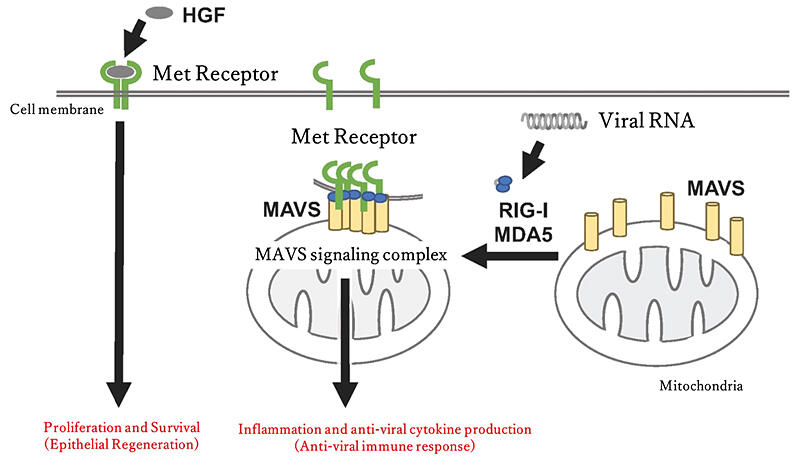A research group led by Assistant Professor Ryu Imamura and Associate Professor Katsuya Sakai of Cancer Research Institute (KU-CRI)/the World Premier International Research Center Initiative (WPI)−Nano Life Science Institute (NanoLSI) at Kanazawa University discovered that Met receptors play an indispensable role in both the antiviral immune response and epithelial cell regeneration. The discovery is expected to enhance integrated understanding of epithelial tissue regeneration and viral infection. The results were published on September 25 in the international academic journal Proceedings of the National Academy of Sciences (PNAS).

Provided by Kanazawa University
Epithelial tissue is the first line of defense against pathogens, such as viruses. The tissue has specialized receptors that recognize molecular patterns derived from pathogens, such as viral RNA, within cells. These receptors activate innate immunity by inducing the production of cytokines, and ultimately contribute to the elimination of the virus.
The Met receptor is a transmembrane tyrosine kinase receptor highly expressed mainly in epithelial cells, playing a crucial role in survival, proliferation, and regeneration. However, the direct relationship between Met receptors and the antiviral response in epithelial cells was still unclear.
The research group found that the antiviral activity of the Met receptor does not require tyrosine kinase activity. Instead, the Met receptor interacts with MAVS (Mitochondrial AntiViral Signaling protein) on the outer membrane of mitochondria. This interaction promotes the formation of the MAVS signaling complex.
These observations suggest that the Met receptor activates the antiviral immune response through a novel mechanism independent of kinase activity, and it plays a dual role in epithelial cell regeneration and the antiviral response.
The Met receptor is involved in the downstream mechanism common to retinoic acid−inducible gene I (RIG-I) and melanoma differentiation−associated gene 5 (MDA5), two pattern recognition receptors that detect viral RNA. Specifically, RIG-I and MDA5 are crucial for the immune response to RNA viruses, such as hepatitis C virus, influenza virus, and SARS-CoV-2. These two receptors could be potential targets for the development of therapeutic drugs against RNA viruses.
Imamura stated, "Infectious diseases caused by viruses are one of the epidemics that humans have not been able to overcome. The immune defense mechanisms carried out by immune cells have been actively researched so far; however, the involvement of the defense mechanisms of epithelial cells, which are the first to encounter viruses, remains largely unclear. The present study results revealed that epithelial cells play a role in virus defense by utilizing the growth factor receptor Met. This finding could lead to prevention and treatment methods for infectious diseases caused by RNA viruses such as coronaviruses, and we can look forward to further developments in this area."
- The Met receptor is a transmembrane tyrosine kinase receptor for hepatocyte growth factor (HGF). It plays crucial roles in the regeneration of cells in various tissues and organs, including epithelial tissues.
Journal Information
Publication: Proceedings of the National Academy of Sciences (PNAS)
Title: Met receptor is essential for MAVS-mediated antiviral innate immunity in epithelial cells independent of its kinase activity
DOI: 10.1073/pnas.2307318120
This article has been translated by JST with permission from The Science News Ltd. (https://sci-news.co.jp/). Unauthorized reproduction of the article and photographs is prohibited.




